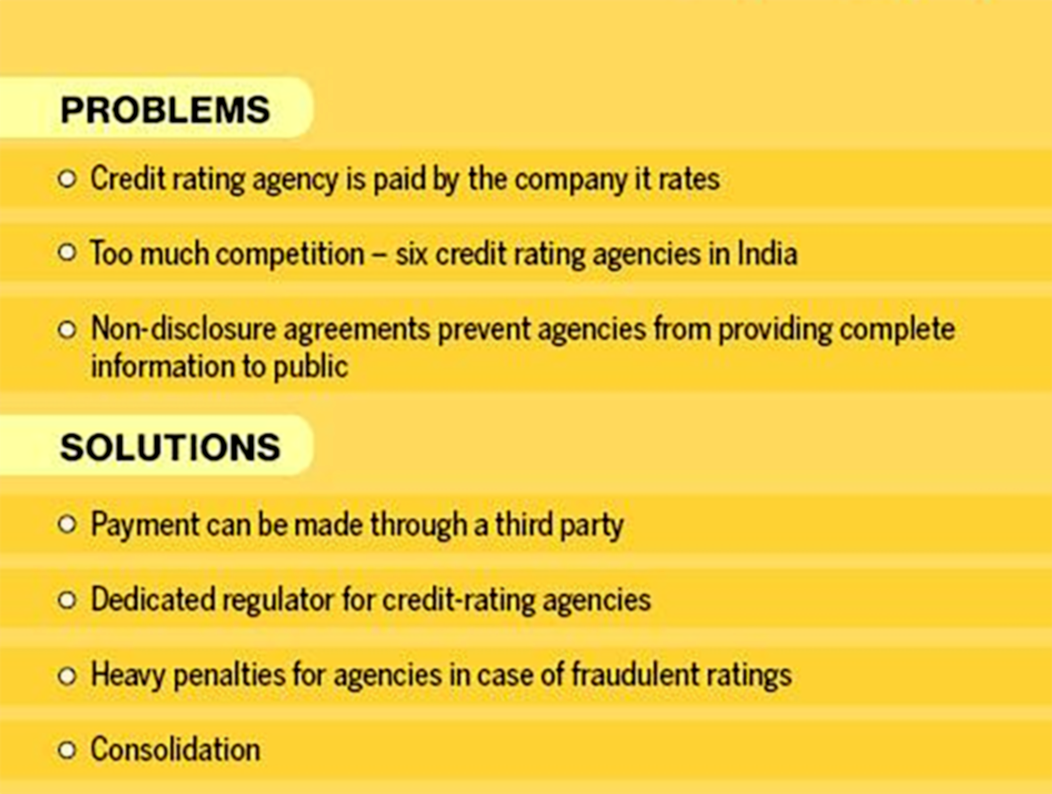
Credit Ratings | 16 Dec 2019
Context
- International ratings agency Moody's Investors Service downgraded India's outlook to negative from stable on concerns that country's economic growth will remain lower than in the past.
- The agency said prolonged financial stress among rural households, weak job creation, and a credit crunch among non-bank financial institutions (NBFIs), have increased the probability of a more “entrenched slowdown”.
- While Moody’s has maintained the country ratings and only lowered the outlook, it still poses risks of capital flight unless the government improves its fiscal health.
What is a Credit Rating?
- A credit rating is a quantified assessment of the creditworthiness of a borrower in general terms or with respect to a particular debt or financial obligation.
- A credit rating can be assigned to any entity that seeks to borrow money—an individual, corporation, state or provincial authority, or sovereign government.
- A sovereign credit rating is an independent assessment of the creditworthiness of a country or sovereign entity.
- Sovereign credit ratings can give investors insights into the level of risk associated with investing in the debt of a particular country, including any political risk.
- Investors use sovereign credit ratings as a way to assess the riskiness of a particular country's bonds.
- Obtaining good sovereign credit rating is usually essential for developing countries in order to access funding in international bond markets.
Rating Agencies
- A rating agency is a company that assesses the financial strength of companies and government entities, especially their ability to meet principal and interest payments on their debts.
- The rating assigned to a given debt shows an agency’s level of confidence that the borrower will honour its debt obligations as agreed.
- The Big Three Credit Rating Agencies: Fitch Ratings, Moody’s Investors Service and Standard & Poor’s (S&P) are the big three international credit rating agencies controlling approximately 95% of global ratings business.
- In India, there are six credit rating agencies registered under SEBI namely, CRISIL, ICRA, CARE, SMERA, Fitch India and Brickwork Ratings.
Role of Rating Agencies in Capital Markets
- Rating agencies assess the credit risk of specific debt securities and the borrowing entities. In the bond market, a rating agency provides an independent evaluation of the creditworthiness of debt securities issued by governments and corporations.
- Rating agencies also give ratings to sovereign borrowers, who are the largest borrowers in most financial markets. Sovereign borrowers include national governments, state governments, municipalities, and other sovereign-supported institutions. The sovereign ratings given by a rating agency shows a sovereign’s ability to repay its debt.
- The ratings help governments from emerging and developing countries to issue bonds to domestic and international investors. Governments sell bonds to obtain financing from other governments and Bretton Woods institutions such as the World Bank and the International Monetary Fund.
Benefits of Rating Agencies
- Investors rely on the ratings given by the credit rating agencies to make investment decisions.
- Many countries sell their securities in the international market, and a good credit rating can help them access high-value investors.
- A favourable rating may also attract other forms of investments like foreign direct investments to a country.
- A low credit rating or relegation of a country from a high rating to a low rating can discourage investors from purchasing the bonds or making direct investments in the country. For example, the downgrading of Greece, Portugal, and Ireland by S&P in 2010 worsened the European sovereign debt crisis.
- The ratings provided by rating agencies also serve as a benchmark for financial market regulations.
Concerns Regarding Rating Agencies
- The big three agencies came under heavy criticism after the global financial crisis of 2008 for giving favourable ratings to insolvent institutions like Lehman Brothers. They were also blamed for failing to detect risky mortgage-backed securities that led to the collapse of the real estate market in the United States.
- Credit rating agencies of India too have come under attack, and also faced regulatory action, besides a probe by central investigating agencies after they had assigned top ratings to borrowings by firms that were part of the IL&FS group in 2018.
- Conflict of Interest: The rating given to any debt shows the agency's level of confidence about the borrower's ability to honour the obligation. Ironically, their primary source of revenue is the fees paid by the company being rated by them.
- Biasness: India often complains that countries with higher levels of debt and a weak fiscal have managed better ratings.
Conclusion
- Despite the sovereign ratings being what they have been for a long time, India has attracted plenty of portfolio and flows into both government and corporate debt, besides Foreign Direct Investment.
- India has not issued a bond or raised money directly in the international market so far, which means that to a good extent, a downgrade has limited impact.
- In fact, the government has responded to the change in outlook by saying that India’s fundamentals are robust and that other macroeconomic indicators such as inflation are still low, which is reflected in low bond yields, with growth prospects strong both in the near and long terms.
- However, India should take the ratings seriously and should engage proactively with the financial market stakeholders to allay their fears and boost the confidence of investors to invest in the Indian economy.
For Mind Map

